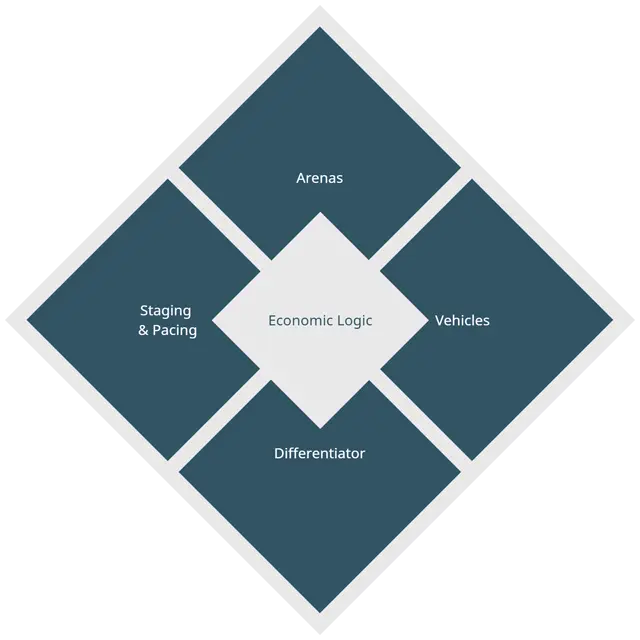One of the important components of any successful business you see today is a well-thought-out strategy. Without a clear roadmap, even the most innovative companies can lose their way. You might be running a small business in any of the major cities in Nigeria like Lagos or let’s say you are in the startup space and you are managing a growing tech startup, the need for a solid strategy cannot be overstated.
Read more about Business
One effective framework that can guide you in developing this strategy is the Strategy Diamond, a concept developed by Professors Donald Hambrick and James Fredrickson. This model breaks down strategy into five essential elements that, when aligned, can help any business thrive. These elements include Arenas, Differentiators, Vehicles, Staging, and Economic Logic. In this post, we will consider what these elements are and how you can develop them.
1. Arenas: Where Will You Compete?
The first element of the Strategy Diamond is Arenas, which asks, “Where will we compete?” This is about defining the specific market spaces your business will operate in. This could be the geographical markets you intend to enter, the product lines you will focus on, or the types of customers you aim to serve. So, it’s about deciding whether to focus on local markets in Nigeria or expand into other West African or European countries.
For instance, if you run a fashion brand in Nigeria, your arena might include targeting young professionals in major cities like Lagos, Abuja, and Port Harcourt, or focusing on trendy, affordable clothing. One business that has mastered this well is the 5kshop by Sophia Ike-Onu which only sells fashion items of not more than 5,000 naira.
Defining your arenas is crucial because it helps you allocate resources effectively and ensures that your business efforts are concentrated where they will have the most impact. Without a clear understanding of your arenas, you risk spreading your business too thin and losing focus on your core competencies.
2. Differentiators: How Will You Win?
Differentiators are what sets your business apart from the competition. This element of the Strategy Diamond asks, “How will we win?” Differentiators are the unique attributes or capabilities that give your business a competitive edge. These could be superior product quality, exceptional customer service, innovative technology, or a strong brand reputation.
For example, if your business offers e-commerce services, your differentiator might be faster delivery times or a more user-friendly online shopping experience compared to your competitors. Differentiators are what convince customers to choose your product or service over others, so it’s important to identify and consistently deliver on these unique selling points.
3. Vehicles: How Will You Get There?
Once you’ve identified where you want to compete and how you’ll win, the next question is: How will you achieve these objectives? Vehicles refer to the means through which you will execute your strategy. Will you grow organically, or will you seek partnerships?
For instance, for a tech startup looking to expand across Africa, the vehicle might be a strategic partnership with a telecommunications company to leverage its existing infrastructure or forming alliances with local companies. This was one of the vehicles that helped Jobberman scale its operations to other African countries. The key is to choose vehicles that align with your long-term goals and resources.
4. Staging: What Will Be Your Speed and Sequence of Moves?
Staging is about timing. It is you answering the question, “What will be our speed and sequence of moves?” This element is particularly important for businesses operating in dynamic environments where market conditions can change rapidly. Should you enter multiple markets at once or focus on dominating one before expanding? Should you launch all your products simultaneously or introduce them gradually?
Take a look at the rise of Opay. When they first came into the Nigerian market, they focused on customer acquisition through the introduction of innovative products in the Nigerian mass market such as Oride. When they felt convinced that they had acquired a substantial number of customers, they launched fully into digital banking.
Proper staging ensures that your business doesn’t overstretch itself and that every move is strategically planned. It’s about knowing when to speed up and when to take things slow, ensuring that every action is well-timed for maximum impact.
5. Economic Logic: How Will You Make Money?
The final element of the Strategy Diamond is Economic Logic, which addresses the all-important question of how your business will generate profits. This could be through cost leadership, premium pricing, or a high volume of sales. Understanding your economic logic ensures that your business model is sustainable and that all other elements of your strategy are aligned with the goal of profitability.
Register to attend the CN Business Mixer
Concluding Thoughts
The Strategy Diamond is a powerful tool that can help any business create a well-rounded and cohesive strategy. By carefully considering each of the five elements—Arenas, Differentiators, Vehicles, Staging, and Economic Logic— you can develop a strategy that not only guides your business decisions but also positions you for long-term success.
Got a suggestion? Contact us: [email protected]


